活动星系核(Active Galactic Nucleus, AGN)是非常特殊的一类河外高光度辐射、高偏振、超大质量中心黑洞的源,其寄主星系被称为活动星系[1]。现普遍认为活动星系核的星系中心有一个超大质量黑洞,中心黑洞通常产生强劲的喷流[2-3]。活动星系核中最为极端的一个子类是耀变体,具有极端相对论速度的喷流,喷流视角很小,喷流方向正好或者几乎正好指向观测者[4],有非常强的相对论聚束效应[5],是研究黑洞吸积、电子加速机制、高能辐射过程非常理想的对象。
耀变体通常分为平谱射电类星体和蝎虎天体两个子类,平谱射电类星体和蝎虎天体之间的经典划分主要基于发射线的等值宽度(Equivalent Width, EW),等值宽度大于0.5 nm的耀变体为平谱射电类星体,反之为蝎虎天体[5-9]。耀变体是活动星系核中数量极少但具有极端物理性质的一类天体, 在光学波段具有大振幅和快速的光变,而且高偏振变化也非常明显,由于喷流产生非热连续的平滑谱且有变化的强射电辐射[7-12]。耀变体的喷流辐射由于相对论的聚束效应而大大增强,主导整个辐射,喷流功率超过整个宿主星系的光度,并且喷流的速度有时超过光速,因此,在观测研究耀变体的喷流方面更好地体现喷流特性。耀变体还具有一些极端的观测特性,如快速大幅光变、视超光速运动、强且变化的光度、高偏振度、非热辐射谱线、核主导等[8-13],这些性质都与喷流效应有关[14]。
一个处于热平衡状态的绝对黑体其热平衡辐射强度仅仅由温度决定,也就是说,如果知道一个热平衡附近近似绝对黑体的辐射强度,就可以得到温度,这个温度就是亮温度(Brightness temperature, TB)[15-16]。在天体物理学中,在非热辐下的星体不具备普朗克形式,且表现为更多的各向异性,但天体物理学家把这类非热辐射折算成热平衡辐射,此时对应的温度叫做非热辐射场的亮温度[16]。亮温度是射电天文学中的常见术语,可以表示为一个非热射电源在某一频率处的强度[15]。耀变体的亮温度是射电亮度的一个参考量,体现了射电磁场与射电光子的某种平衡关系[17]。亮温度在活动星系核成束效应的研究中十分重要,对研究喷流的性质也极其重要[16]。射电喷流的关键物理性质与存储在辐射粒子中的能量和存储在磁场中的能量之间关系密切[18-20]。
本文利用黑洞喷流能量的计算方法,应用红移和15 GHz能量密度的喷流能量计算公式,计算黑洞喷流能量,搜集了已发表文献中的亮温度数据,研究耀变体的亮温度与黑洞喷流能量之间存在的关联,并对产生的关联进行分析与讨论。
1 黑洞喷流能量及亮温度的计算 1.1 黑洞喷流能量的计算本文喷流能量的计算方法与文[21]相同,利用耀变体的射电流量密度观测数据估算喷流能量, 耀变体大部分的射电瓣能量存在于等离子体中。假设喷流能量转化为瓣能量所用的时间与射电瓣从黑洞中心区域分离的时间tsep相同,通过研究射电瓣的射电谱线曲率可以测定其中等离子体的寿命(分布在黑洞中心区域的等离子体可能在射电瓣形成之初就存在),进而可以推算射电瓣的寿命及演化速率。设截止频率为vb,同步周期(以cgs为单位)可以表示为
| $ {t_{{\rm{sep}}}} \approx 1.58 \times {10^{12}}{B^{ - 3/2}}v_{\rm{b}}^{ - 1/2}, $ | (1) |
其中,B为磁场强度依据高能粒子的幂律分布,利用热洛伦兹因子γ将数据源设为一个体积为V的均匀光源,则频率在v1≤v≤v2之间的同步辐射可表示为
| $ {N_{\rm{r}}} = {N_0}V\int\limits_{{\gamma _1}}^{{\gamma _2}} {{\gamma ^{ - n}}} d\gamma . $ | (2) |
(2) 式中的最大和最小洛伦兹因子与同步辐射的上限截止频率v1和下限截止频率v2有关:
| $ {\gamma _1} = {\left[ {\frac{{2{v_1}{y_1}(n)}}{{3{v_{\rm{B}}}}}} \right]^{1/2}}, {\gamma _2} = {\left[ {\frac{{2{v_2}{y_2}(n)}}{{3{v_{\rm{B}}}}}} \right]^{1/2}}. $ | (3) |
其中,vB=eB/2πmec为粒子回旋加速频率;
| $ \begin{array}{*{20}{l}} {{y_1}(n) = 2.2, {y_2}(n) = 0.10, \;\;(n = 2.5);}\\ {{y_1}(n) = 2.7, {y_2}(n) = 0.18, \;\;(n = 3.0).} \end{array} $ | (4) |
同步辐射光度L(v)是一个与动量空间的粒子分布和磁场强度有关的函数。结合粒子分布下同步辐射功率的公式
| $ {U_{\rm{e}}} \approx \frac{{2 \times {{10}^{11}}{B^{ - 3/2}}}}{{a(n)(n - 2)}}L\left( {{v_1}} \right)v_1^{1/2}{\left[ {{y_1}(n)} \right]^{(n - 1)/2}}\left\{ {1 - {{\left[ {\frac{{{y_2}(n){v_1}}}{{{y_1}(n){v_2}}}} \right]}^{(n - 1)/2}}} \right\}, $ | (5) |
其中,
| $ {U_{\rm{e}}} \approx \frac{{L\left( {{v_1}} \right){{\left( {{v_1}} \right)}^{1/2}}{{\left( {{v_b}} \right)}^{1/2}}}}{{7.9(n - 2)a(n)}}{\left[ {{y_1}(n)} \right]^{(n - 1)/2}}{t_{{\rm{syn}}}}. $ | (6) |
将截止频率代入(6)式,由tsep≈tsyn可得喷流能量为
| $ Q \approx \frac{{{U_{\rm{e}}}}}{{{t_{{\rm{sep}}}}}} + L \approx \frac{{{{\left[ {{y_1}(n)} \right]}^{\frac{{n - 1}}{2}}}{{(15.1)}^\alpha }}}{{(n - 2)a(n)}} \times {10^{42}}{(1 + z)^{1 + \alpha }}{Z^2}{F_{15}}{\rm{ergs}} \cdot {{\rm{s}}^{ - 1}} + L, $ | (7) |
其中,α为谱指数[L(v)~v-α], α=(n-1)/2;z为红移。由于原子组成的射电瓣气体的存在及低频部分射电谱线的延伸,喷流能量的估算值偏大,为了使结果更加精准,需要对公式的谱指数进行校正。经过长期的观测与验证,得出谱指数α≈1为(7)式最佳的基准值[21],由此可得到基于红移和15 GHz能量密度的喷流能量计算公式
| $ {Q_{{\rm{jet}}}} \approx 5.7 \times {10^{44}}{(1 + z)^{1 + \alpha }}{Z^2}{F_{15}}{\rm{ergs}} \cdot {{\rm{s}}^{ - 1}}, \;\alpha \approx 1. $ | (8) |
在天体物理学中,许多辐射不是热辐射,而是非热辐射,例如同步辐射和逆康普顿散射等,但是通常把这类辐射折算成一定温度下的热平衡辐射,以便于比较。如果某一方向n上某一给定频率的非热辐射的强度Iv(n)=Iveq,则该温度Tb就定义为这个辐射场的亮度,经典极限下,hν=KT亮温度为
| $ k{T_{\rm{b}}} = {c^2}{I_v}(n)/2{v^2}, $ | (9) |
在射电天文学中,亮温度通常等效表示为一个非热射电源在某一频率位置处的强度。亮温度可以用光变时标表示[22]:
| $ {T_{\rm{b}}} = \left( {4.5 \times {{10}^{10}}{\rm{K}}} \right)F{\left[ {\frac{{\lambda d}}{{{t_{{\rm{obs}}}}(1 + z)}}} \right]^2}, $ | (10) |
其中,F为流量密度;λ为波长;d为距离;Tb为亮温度;tobs为时标,分别以Jy, cm, Mpc和d为单位。
2 样本选择本文从文献中收集了射电波段的53个耀变体源,包括22个蝎虎天体和31个平谱射电类星体。耀变体样本数据包括(1)源名称;(2)类型;(3)红移;(4)15 GHz时的流量密度(单位为央斯基),来源于河外星系数据库与欧文斯谷数据库;(5)亮温度Tb(单位为K);(6)黑洞喷流能量Qjet;(7)黑洞吸积率。利用(8)式计算黑洞喷流能量,计算黑洞喷流能量所需要的15 GHz流量密度F均来源于河外星系数据库与欧文斯谷数据库,以上数据列于表 1[23-28]。本文讨论了亮温度与黑洞喷流能量、黑洞吸积率之间的相关性,数据按源的国际天文学联合会(International Astronomical Union, IAU)名称由小到大排列。
| Name | Type | Z | F15 GHz/Jy | logTb/K | Refs | logQjet/ergs·s-1 | Rate | Refs |
| 0003-066 | BL Lac | 0.347 | 3.029 5 | 12.23 | [23] | 44.576 6 | - | |
| 0016+731 | FSRQ | 1.781 | 1.767 1 | 14.23 | [25] | 46.392 9 | - | |
| 0048-097 | BL Lac | 0.2 | 0.759 0 | 13.42 | [25] | 43.396 5 | - | |
| 0106+013 | FSRQ | 2.107 | 2.974 7 | 13.45 | [23] | 46.861 3 | - | |
| 0133+476 | FSRQ | 0.859 | 3.080 7 | 13.85 | [25] | 45.651 1 | - | |
| 0212+735 | FSRQ | 2.367 | 2.961 4 | 14.29 | [22] | 47.030 3 | - | |
| 0215+015 | BL Lac | 1.715 | 1.267 8 | 13.64 | [22] | 46.199 9 | - | |
| 0306+102 | FSRQ | 0.863 | 1.121 7 | 12.74 | [23] | 45.218 2 | - | |
| 0336-019 | FSRQ | 0.852 | 2.391 2 | 13.70 | [23] | 45.530 7 | 0.218 8 | [26] |
| 0420-014 | FSRQ | 0.915 | 4.177 6 | 14.02 | [23] | 45.864 | 0.123 4 | [26] |
| 0528+134 | FSRQ | 2.067 | 1.683 6 | 15.29 | [25] | 46.586 2 | 0.166 0 | [26] |
| 0605-085 | FSRQ | 0.872 | 2.866 7 | 13.22 | [25] | 45.638 9 | - | |
| 0607-157 | FSRQ | 0.324 | 3.380 7 | 13.67 | [23] | 44.549 7 | 0.416 6 | |
| 0735+178 | BL Lac | 0.424 | 0.787 6 | 13.18 | [23] | 44.213 9 | 0.036 6 | [27] |
| 0754+100 | BL Lac | 0.66 | 1.182 1 | 13.99 | [24] | 44.907 8 | 0.026 2 | [27] |
| 0808+109 | BL Lac | 0.407 | 0.853 9 | 13.59 | [24] | 44.203 1 | - | |
| 0814+425 | BL Lac | 0.245 | 1.147 4 | 12.10 | [24] | 43.784 3 | - | |
| 0829+046 | BL Lac | 0.23 | 0.818 2 | 13.14 | [23] | 43.572 0 | - | |
| 0923+392 | FSRQ | 0.695 | 9.407 2 | 12.73 | [25] | 45.871 6 | 0.095 5 | [28] |
| 0954+658 | BL Lac | 0.367 | 1.220 0 | 13.72 | [24] | 44.243 1 | - | |
| 1038+528 | FSRQ | 2.296 | 0.624 9 | 13.20 | [24] | 46.309 6 | - | |
| 1055+018 | FSRQ | 0.888 | 5.249 1 | 14.20 | [23] | 45.924 8 | - | |
| 1156+295 | FSRQ | 0.729 | 1.861 8 | 14.35 | [24] | 45.226 9 | 0.084 3 | [27] |
| 1219+285 | BL Lac | 0.13 | 0.485 9 | 11.32 | [25] | 42.776 5 | 0.056 7 | [28] |
| 1226+023 | FSRQ | 0.158 | 24.013 8 | 13.74 | [24] | 44.661 1 | 0.076 7 | [27] |
| 1253-055 | FSRQ | 0.536 | 18.122 7 | 13.26 | [25] | 45.845 2 | 0.093 2 | [26] |
| 1307+121 | BL Lac | 0.407 | 0.627 5 | 11.66 | [23] | 44.069 3 | - | |
| 1308+326 | BL Lac | 0.996 | 2.094 8 | 14.59 | [23] | 45.673 9 | 0.020 1 | [28] |
| 1335-127 | FSRQ | 0.539 | 4.857 9 | 13.81 | [24] | 45.280 0 | - | |
| 1413+135 | BL Lac | 0.247 | 0.781 4 | 13.88 | [25] | 43.625 9 | - | |
| 1418+546 | BL Lac | 0.151 | 1.240 3 | 12.74 | [25] | 43.329 5 | - | |
| 1504-166 | FSRQ | 0.876 | 0.970 7 | 13.08 | [23] | 45.174 4 | - | |
| 1538+149 | BL Lac | 0.605 | 0.984 5 | 12.97 | [23] | 44.723 6 | 0.049 5 | [28] |
| 1606+106 | FSRQ | 1.23 | 0.814 7 | 13.85 | [23] | 45.543 3 | - | |
| 1611+343 | FSRQ | 1.401 | 3.765 5 | 12.98 | [25] | 46.385 4 | 0.263 0 | [26] |
| 1633+382 | FSRQ | 1.814 | 3.221 7 | 13.57 | [25] | 46.679 9 | 0.168 2 | [26] |
| 1637+574 | FSRQ | 0.751 | 1.462 6 | 13.99 | [24] | 45.158 9 | 0.316 2 | [26] |
| 1641+399 | FSRQ | 0.594 | 6.260 9 | 14.03 | [24] | 45.505 1 | 0.295 1 | [27] |
| 1642+690 | FSRQ | 0.751 | 2.412 2 | 12.94 | [23] | 45.376 1 | 1.047 1 | [27] |
| 1717+178 | BL Lac | 0.407 | 0.740 8 | 12.26 | [23] | 44.141 4 | - | |
| 1730-130 | FSRQ | 0.9 | 4.508 1 | 14.62 | [25] | 45.875 9 | - | |
| 1741-038 | FSRQ | 1.054 | 4.203 3 | 13.71 | [25] | 46.050 3 | - | |
| 1749+096 | BL Lac | 0.322 | 3.684 3 | 14.39 | [24] | 44.580 4 | 0.029 1 | [28] |
| 1749+701 | BL Lac | 0.77 | 0.701 8 | 13.12 | [25] | 44.871 | - | |
| 1803+784 | BL Lac | 0.679 | 2.530 5 | 13.41 | [25] | 45.272 9 | - | |
| 1823+568 | BL Lac | 0.664 | 1.365 3 | 12.59 | [23] | 44.977 7 | - | |
| 1928+738 | FSRQ | 0.36 | 4.359 7 | 13.34 | [23] | 44.775 0 | 0.588 8 | [27] |
| 2007+777 | BL Lac | 0.342 | 0.943 4 | 13.41 | [23] | 44.0541 | - | |
| 2121+053 | FSRQ | 1.025 | 1.770 0 | 13.95 | [24] | 45.638 1 | - | |
| 2131-021 | BL Lac | 1.285 | 2.247 3 | 13.93 | [24] | 46.043 1 | - | |
| 2136+141 | FSRQ | 2.427 | 2.276 0 | 12.90 | [24] | 46.953 0 | - | |
| 2145+067 | FSRQ | 0.99 | 4.013 9 | 13.31 | [25] | 45.948 4 | - | |
| 2155-152 | FSRQ | 0.672 | 3.142 9 | 12.49 | [23] | 45.354 4 | 1.202 3 | [26] |
| 设X=Tb;Y=logQjet;Y=A+BX;N为样品数;R为相关系数。由表 1数据做最小二乘法相关性分析[29],结果如表 2。 | ||||||||
| X | Y | R | prob>F | A (Intercept) | Error (Intercept) | B (Slope) | Error (Slope) | N Type |
| Tb | LogQjet | 0.457 7 | 0.194 0 | 37.042 | 2.225 | 0.608 | 0.165 | 53- |
| Tb | LogQjet | 0.181 4 | 0.001 7 | 43.033 | 2.638 | 0.199 | 0.194 | 31 FSRQ |
| Tb | LogQjet | 0.515 4 | 0.227 0 | 37.441 | 2.266 | 0.529 | 0.202 | 22 BL Lac |
| Tb | Rate | -0.291 4 | -0.036 7 | 1.763 | 1.137 | -0.111 | 0.084 | 21- |
| 注:表中“-”表示BL Lac和FSRQ整体讨论的情况。 | ||||||||
蝎虎天体和平谱射电类星体的黑洞喷流能量的分布见图 1、图 2,由图 1、图 2可以看出,蝎虎天体和平谱射电类星体的黑洞喷流能量分布存在明显的差异。平谱射电类星体的黑洞喷流能量大部分集中在1044.5~1047 ergs·s-1,而蝎虎天体的黑洞喷流能量大部分集中在1042~1045 ergs·s-1。
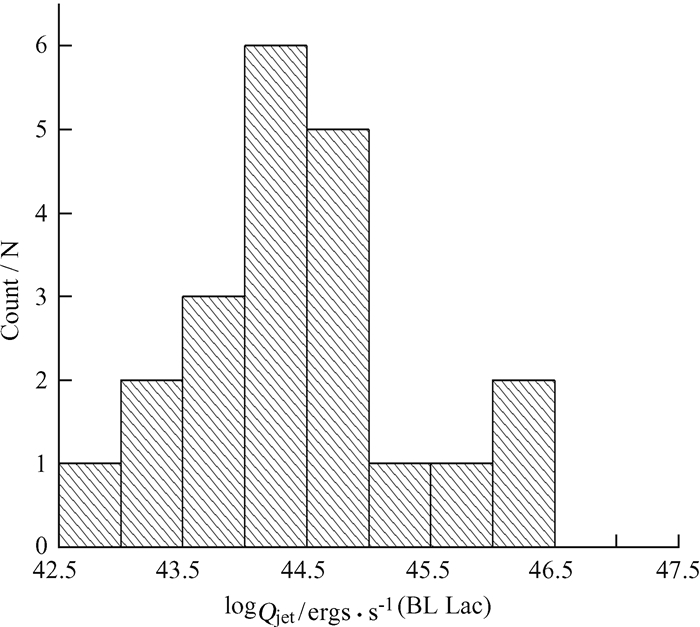
|
| 图 1 蝎虎天体黑洞喷流能量的分布 Fig. 1 The distribution of the jet energy of BL Lac |
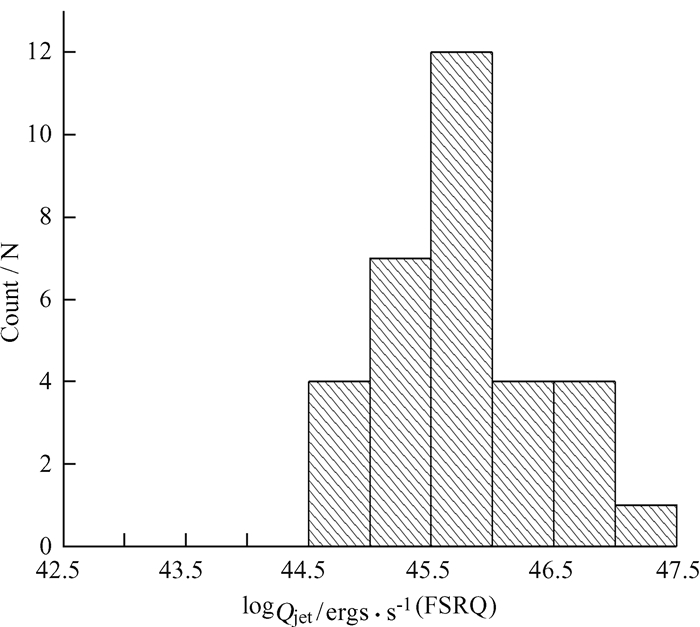
|
| 图 2 平谱射电类星体黑洞喷流能量的分布 Fig. 2 The distribution of the jet energy of FSRQs |
蝎虎天体和平谱射电类星体的亮温度分布见图 3、图 4,由图 3、图 4可以看出,蝎虎天体和平谱射电类星体的亮温度分布存在一定的差异,但大体趋势较为相似。蝎虎天体和平谱射电类星体的亮温度大部分集中在1013~1014 K,但蝎虎天体的亮温度在1011~1013 K的分布较为均匀,平谱射电类星体的亮温度在1012.5~1014.5 K的分布较为均匀。出现这样的分布情况可能与蝎虎天体、平谱射电类星体的内禀性质有关。内禀性质最明显的表现为有无发射线及发射线的强弱,本文认为,这是造成上述分布的原因之一。
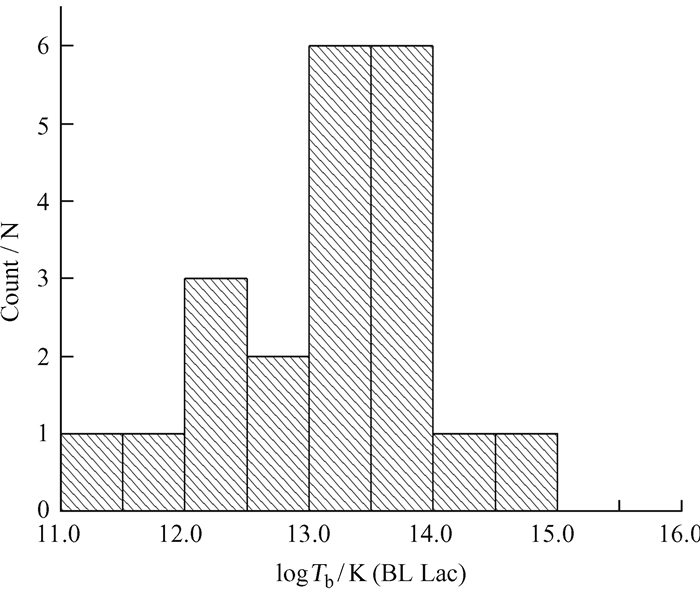
|
| 图 3 蝎虎天体亮温度的分布 Fig. 3 The distribution of the bright temperature of BL Lac |
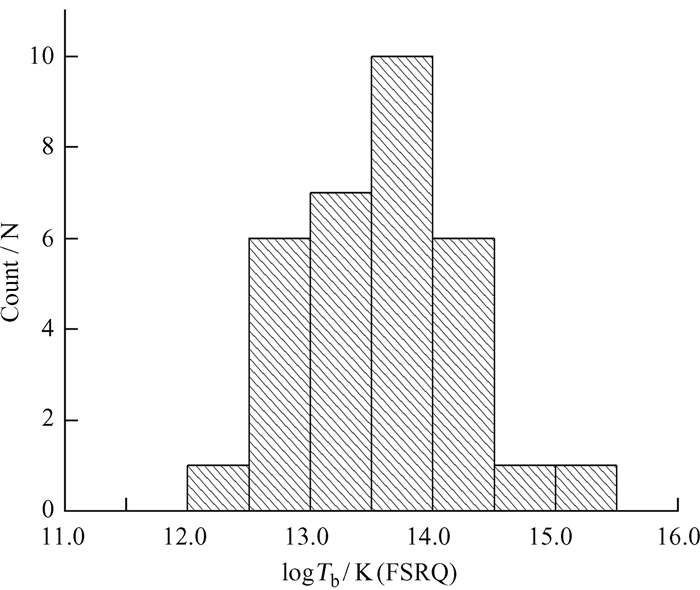
|
| 图 4 平谱射电类星体亮温度的分布 Fig. 4 The distribution of the bright temperature of FSRQS |
耀变体的亮温度与黑洞喷流能量的关系见图 5,由图 5可以看出,耀变体的亮温度与黑洞喷流能量具有较高的相关性(R=0.457 7,p=0.194 0),说明黑洞的喷流能量与亮温度之间存在联系,亮温度可以用来描述黑洞喷流能量。蝎虎天体的亮温度与黑洞喷流能量的关系见图 6,由图 6可以看出,蝎虎天体的亮温度与黑洞喷流能量之间有较强的相关性(R=0.515 4,p=0.227 0),说明蝎虎天体的亮温度与黑洞喷流能量之间存在联系,亮温度可以在一定程度上描述蝎虎天体的黑洞喷流能量,亮温度大的蝎虎天体喷流携带的能量也较大,表现为亮温度越大,黑洞喷流能量越大。
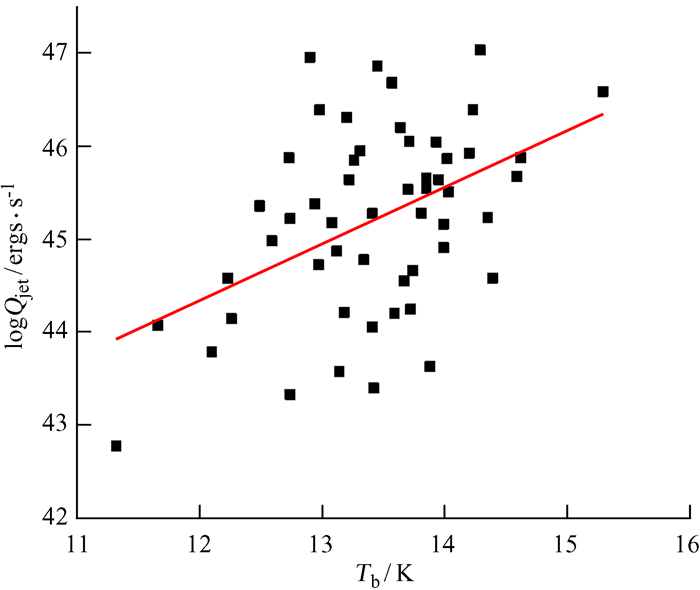
|
| 图 5 亮温度与黑洞喷流能量(耀变体) Fig. 5 Brightness temperature and jet energy of black hole (Blazars) |
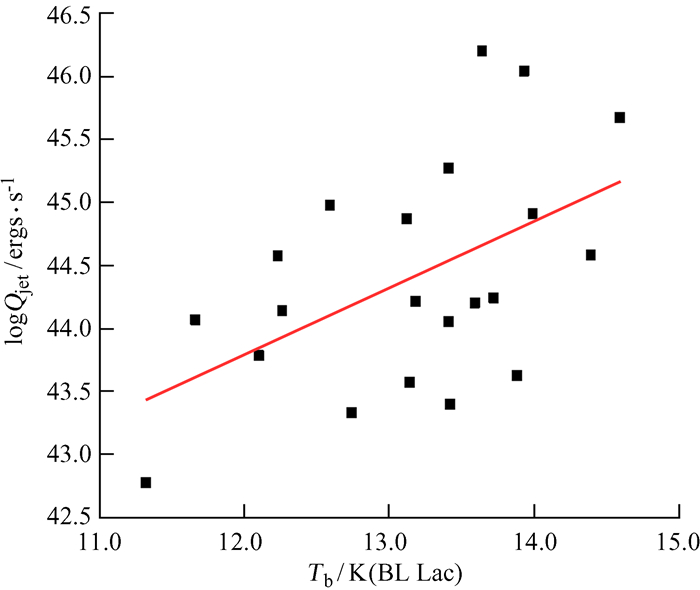
|
| 图 6 亮温度与黑洞喷流能量(蝎虎天体) Fig. 6 Brightness temperature and jet energy of black hole (BL Lac) |
平谱射电类星体的亮温度与黑洞喷流能量的关系见图 7,由图 7可以看出,平谱射电类星体的亮温度与黑洞喷流能量之间有弱相关性(R=0.181 4,p=0.001 7),平谱射电类星体的亮温度与黑洞喷流能量之间存在弱相关性,亮温度不能清楚地描述黑洞喷流能量,说明平谱射电类星体的黑洞喷流能量受亮温度的影响较小,黑洞喷流能量很可能受到其他因素的影响。

|
| 图 7 亮温度与黑洞喷流能量(平谱射电类星体) Fig. 7 Brightness temperature and jet energy of black hole (FSRQ) |
耀变体的亮温度与黑洞吸积率的关系见图 8,由图 8可以看出,耀变体的亮温度与黑洞吸积率存在反相关性(R=-0.291 4,p=-0.036 7),说明耀变体的亮温度也可以用来描述黑洞吸积率,亮温度越高,黑洞吸积率越小。由于搜集的蝎虎天体黑洞吸积率的数据太少,本文没有分开讨论蝎虎天体和平谱射电类星体的亮温度与黑洞吸积率的相关性。同时,由于耀变体的数据较少,数据的弥散度很大,所以在图中的相关性不明显。
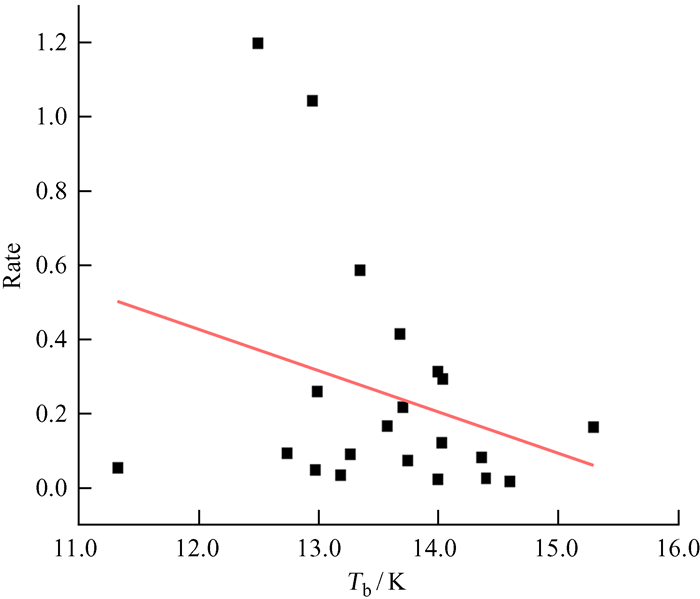
|
| 图 8 亮温度与黑洞吸积率(耀变体) Fig. 8 Brightness temperature and Black hole accretion rate (Blazars) |
本文收集的蝎虎天体和平谱射电类星体在一定程度上说明了亮温度与黑洞喷流能量之间存在相关性。虽然蝎虎天体和平谱射电类星体整体亮温度与黑洞喷流能量存在一定的相关性,但是蝎虎天体和平谱射电类星体各自的亮温度与黑洞喷流能量之间的相关性存在较大的差异:蝎虎天体的亮温度与黑洞喷流能量之间的相关性较强,而平谱射电类星体亮温度与黑洞喷流能量之间相关性却较弱。这可能由以下原因造成:
(1) 蝎虎天体与平谱射电类星体的光度大小不同;
(2) 两类星体核的活动不同;
(3) 蝎虎天体与平谱射电类星体的内禀性质的不同,最明显表现为蝎虎天体和平谱射电类星体发射线的有无以及发射线的强弱;
(4) 整体的亮温度与黑洞喷流能量的相关性可能受蝎虎天体和平谱射电类星体自身性质的影响;
(5) 耀变体的亮温度与黑洞吸积率之间存在弱的反相关关系,但由于数据较少,不能认为亮温度是影响黑洞吸积率的绝对因素。
由此可以推断,蝎虎天体的黑洞喷流能量的大小可能由亮温度、黑洞质量及其他因素共同决定,这与文[27]的结论一致。同时,也可以推断亮温度是影响耀变体的黑洞吸积率的一个重要因素。
致谢: 本文用于计算黑洞喷流能量的15 GHz流量密度均源于NASA/IPAC河外星系数据库(NED)和欧文斯谷射电天文台官网(http://www.astro.caltech.edu/ovroblazars/),在此表示感谢!
| [1] |
黄克谅. 类星体和活动星系核[M]. 北京: 中国科学出版社, 2005. HUANG K L. Quasars and active galactic nuclei[M]. Beijing: China Science Press, 2005. |
| [2] | ALLEN S W, DUNN R J H, FABIAN A C, et al. The relation between accretion rate and jet power in X-ray luminous elliptical galaxies[J]. Monthly Notices of the Royal Astronomical Society, 2006, 372: 21–30. DOI: 10.1111/j.1365-2966.2006.10778.x |
| [3] | MIRABEL I F, RODRIGUEZ L F. Sources of relativistic jets in the galaxy[J]. Annual Review of Astronomy and Astrophysics, 1999, 37: 409–443. DOI: 10.1146/annurev.astro.37.1.409 |
| [4] | URRY C M, PADOVANI P. Unified schemes for radio-loud Active Galactic Nuclei[J]. Publications of the Astronomical Society of the Pacific, 1995, 107: 803–845. DOI: 10.1086/133630 |
| [5] | 陈永云. 活动星系核黑洞质量、偏振及喷流特性研究[D]. 昆明: 云南师范大学, 2016. CHEN Y Y. Mass polarization and jet characteristics of active galactic core black holes[D]. Kunming: Yunnan Normal University, 2016. |
| [6] | SCARPA R, FALOMO R. Are high polarization quasars and BL Lacertae objects really different? A study of the optical spectral properties[J]. Astronomy & Astrophysics, 1997, 325(1): 109–123. |
| [7] | 丁楠. 耀变体喷流及光变的物理特性研究[D]. 昆明: 云南师范大学, 2017. DING N. Study on the physical properties of jet and light variation of Blazars[D]. Kunming: Yunnan Normal University, 2017. |
| [8] | 王泽睿. 耀变体喷流的辐射机制研究[D]. 昆明: 云南师范大学, 2018. WAN Z R. Study on the radiation mechanism of the blazar jet[D]. Kunming: Yunnan Normal University, 2018. |
| [9] | XIONG D R, ZHANG X. Intrinsic γ-ray luminosity, black hole mass, jet and accretion in Fermi blazars[J]. Monthly Notices of the Royal Astronomical Society, 2014, 441(4): 3375–3395. DOI: 10.1093/mnras/stu755 |
| [10] | MILLERJ S. Optical evidence for the unification of active galactic nuclei and quasi-stellar objects[J]. Proceedings of the National Academy of Sciences of the United States of America, 1995, 92(25): 11422–11426. DOI: 10.1073/pnas.92.25.11422 |
| [11] | BREGMAN J N. Continuum radiation from active galactic nuclei[J]. The Astronomy and Astrophysics Review, 1990, 2(2): 125–166. DOI: 10.1007/BF00872765 |
| [12] | STOCKE J T, MORRIS S L, GIOIA I, et al. No evidence for radio-quiet BL Lacertae objects[J]. The Astrophysical Journal, 1990, 348: 141–146. DOI: 10.1086/168221 |
| [13] | FICHTEL C E, BERTSCH D L, CHIANG J, et al. The first Energetic Gamma-Ray Experiment Telescope (EGRET) source catalog[J]. The Astrophysical Journal Supplement, 1994, 94(2): 551–581. |
| [14] | FAN J H, HUANG Y, HE T M, et al. Radio variability and relativistic beaming effect for Blazars[J]. Publications of the Astronomical Society of Japan, 2009, 61(4): 639–643. DOI: 10.1093/pasj/61.4.639 |
| [15] |
尤俊汉. 天体物理中的辖射机制[M]. 第2版. 北京: 科学出版社, 1998. YOU J H. The mechanism of governance in astrophysics[M]. 2nd ed. Beijing: Science Press, 1998. |
| [16] | 肖胡兵. 耀变体成束效应的研究[D]. 广州: 广州大学, 2017. XIAO H B. The study of Blazar'sbeaming effect in AGNs[D]. Guangzhou: Guangzhou University, 2017. |
| [17] | READHEAD A C S. The radio jet velocities at high resolution[J]. The Astrophysical Journal, 1994, 426(1): 51–59. |
| [18] | BURBIDGE G R. Estimates of the total energy in particles and magnetic field in the non-thermal radio sources[J]. The Astrophysical Journal, 1959, 129: 849–852. DOI: 10.1086/146680 |
| [19] | CROSTON J H, HARDCASTLE M J, HARRIS D E, et al. An X-ray study of magnetic field strengths and particle content in the lobes of FR Ⅱ radio sources[J]. The Astrophysical Journal, 2005, 626(2): 733–747. DOI: 10.1086/430170 |
| [20] | HOMAN D C, KOVALEV Y Y, LISTER M L, et al. Intrinsic brightness temperatures of AGN jets[J]. The Astrophysical Journal, 2006, 642: 115–120. DOI: 10.1086/504715 |
| [21] | CHICONE C, MASHHOON B, PUNSLY B. Relativistic motion of spinning particles in a gravitational field[J]. Physics Letters A, 2005, 343(1): 1–7. |
| [22] | WAGNER S J, WITZEL A. Intraday variability in quasars and BL Lac objects[J]. Annual Review of Astronomy and Astrophysics, 1995, 33: 163–197. DOI: 10.1146/annurev.aa.33.090195.001115 |
| [23] | HOVATTA T, VALTAOJA E, TORNIKOSKI M, et al. Doppler factors, Lorentz factors and viewing angles for quasars, BL Lacertae objects and radio galaxies[J]. Astronomy & Astrophysics, 2009, 494(2): 527–537. |
| [24] | FAN J H, HUANG Y, HE T M, et al. Radio variability and relativistic beaming effect for Blazars[J]. Publications of the Astronomical Society of Japan, 2009, 61(4): 639–643. DOI: 10.1093/pasj/61.4.639 |
| [25] | LAHTEENMAKI A, VALTAOJA E. Total flux density variations in extragalactic radio sources. Ⅲ. Doppler boosting factors, Lorentz factors, and viewing angles for Active Galactic Nuclei[J]. The Astrophysical Journal, 1999, 521(2): 493–501. DOI: 10.1086/307587 |
| [26] | CAO X W, JIANG D R. Correlation between radio and broad-line emission in radio-loud quasars[J]. Monthly Notices of the Royal Astronomical Society, 1999, 307(2): 802–811. |
| [27] |
张旭, 张雄. 黑洞吸积率与喷流能量相关性讨论[J]. 天文研究与技术, 2016, 13(1): 24–30 ZHANG X, ZHANG X. The relation between the accretion rate and the jet power[J]. Astronomical Research & Technology, 2016, 13(1): 24–30. DOI: 10.3969/j.issn.1672-7673.2016.01.003 |
| [28] | XIE G Z, HAO P J, LU R W, et al. Optical behaviour of four BL lacertae objects[J]. Chinese Astronomy and Astrophysics, 1988, 12(3): 197–204. DOI: 10.1016/0275-1062(88)90047-1 |
| [29] |
张雄. 物理实验设计与研究[M]. 第2版. 北京: 科学出版社, 2001: 63-73. ZHANG X. Physics experiment design and research 2nd ed[M]. 2nd ed. Beijing: Science Press, 2001: 63-73. |



